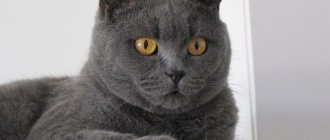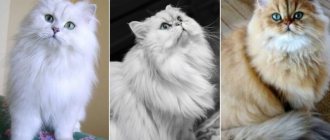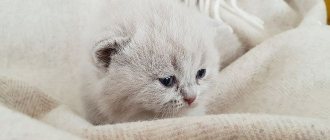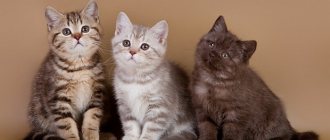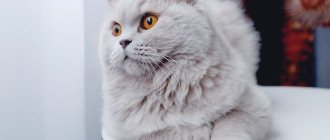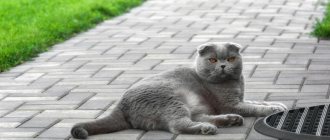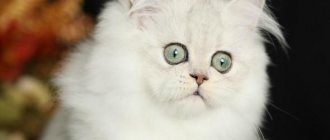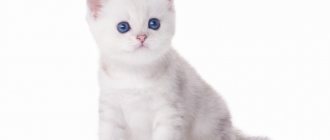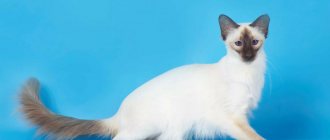The British chinchilla has a submissive, soft, calm character. This charming creature will fill your home with comfort and love, and will become a loyal friend and companion.
Due to its resemblance to the famous animal, the cat breed is sometimes simply called chinchilla. The plush fur coat and unusually sweet and expressive eyes of the British aristocrat captivate at first sight. This exquisite feline requires a lot of attention and careful care.
Origin of the species and description
Photo: British Golden Chinchilla
Breeders from Great Britain artificially bred it as a result of crossing Persians with the British. Today, there are several options for the origin of this type of breed. The origin story is described differently in different sources. Some indicate that the subspecies was first bred in England, while others indicate that scientists and breeders from America were involved in their breeding.
They were called chinchillas due to the fact that their color is very similar to the natural color of chinchillas. British scientists selected exclusively smoky or peach-colored cats for crossing. Initially, as a result of experiments, animals with green eyes and chinchilla color appeared.
Video: British Golden Chinchilla
The very first kitten was born as a result of crossing in 1882. A female kitten named Shannie was born from a Persian cat and a British smoke-colored cat. After this, breeders continued to work on developing ideal representatives of this breed. In 1889, a kitten was born who was named Silver Lambkin. It is this kitten that is considered the ancestor of this type of breed. It was presented as a result of breeding work at numerous exhibitions, where it became a multiple winner.
Interesting fact: Swedish Princess Victoria adored these animals and kept several representatives of this breed in her palace. The princess called them plushies and in every possible way contributed to their breeding and distribution.
For a long period of time, breeders sought to breed cats that would have emerald eyes. However, admixtures of different breeds did not allow achieving the desired result.
Predisposition to diseases
The British Shorthair has a long history, and one of the results of meticulous selection is that these animals have excellent health and excellent disposition. This is a long-lived breed. However, due to crossbreeding with Persian cats, some members of the chinchilla variety sometimes have kidney disease, although this is not common.
Polycystic kidney disease and blood type B
In the 20th century, British Shorthair breeders used Persian cats to create a chinchilla line.
Persians are prone to an inherited kidney disease called polycystic kidney disease. Since then, outbreaks of this disease have been periodically reported in the UK. A more common problem for British cats is the rare blood type that some of these cats have. British Shorthairs can be Type A or Type B. Most have Type A blood. Some have Type B. It is not a blood disorder, and Type B cats are just as healthy as Type A cats. But for breeding purposes or if blood transfusions are needed this must be taken into account. Type A blood will kill a cat with type B blood and vice versa.
British shorthair breeders are worried about blood type due to "fading kitten" syndrome. When the mother cat has type B blood and the father of the kittens has type A blood, their kittens can have both type A and type B blood. Mother's milk contains antibodies to type A, which will kill type A kittens within 72 hours. Fortunately, there is now a DNA test to check the blood type before breeding a cat.
Appearance and features
Photo: What does a British golden chinchilla look like?
The British Golden Chinchilla has external characteristics typical of British cats. Representatives of this breed have a rather large body and a wide chest. Cats have a straight back line and a defined hip line. The body is quite squat with well-developed muscles.
Representatives of this breed have characteristic features:
- neat rounded head shape with a wide, majestic forehead;
- pronounced, large cheeks and cheekbones;
- wide, short, straight nose;
- the tip of the nose is pink or peach-colored;
- the ears are small, rounded, widely spaced from each other;
- the neck is shortened, muscular and strong;
- large, expressive eyes that are quite deep-set;
- limbs are short and strong, rounded, arranged proportionally. In the spaces between the toes there are tufts of thick hair;
- the tail is short, not long, thick.
Individuals of this species exhibit pronounced sexual dimorphism. Males have larger body sizes and weight. The average body weight of males is 6-8 kilograms, females 3-3.5 kilograms. Spayed or neutered individuals can reach almost double their body weight. The coat of British cats is quite dense, short and dense with a well-developed undercoat.
Among the colors, I distinguish three main types:
- silver - white predominates in this color scheme. The color is distributed in such a way that the undercoat is completely white, and the tips are darker, almost black. The chest and abdomen area is crystal white, the pads of the limbs, on the contrary, are black. The area of the eyes and nose is highlighted with a black outline, as if outlined with a pencil;
- golden - undercoat of a pronounced, rich apricot color. The tail, side surface of the body and the back line are painted in a darker color. The chest and belly area is a softer, lighter caramel color;
- ash - when compared with the usual silver color, the coat is darker. This is due to the fact that the guard hair is colored one-third dark, and the silver color is characterized by the guard hair being dyed the main color by 1/8. There are stripes of a darker color on the body, although they do not have clearly defined boundaries. Between the toes the fur is dark, almost black;
- Zoologists and breeders identify another color - color point. They have more pronounced external characteristics of Siamese cats. They are distinguished by the presence of blue eyes. And a darker eye color in the area of the ears, tail and eyes.
History of the breed
The first chinchilla cat was obtained in America in 1880, so the USA is considered to be the animal’s country of origin.
An ordinary smoky cat with a silver tabby gave birth to a “girl” with an original color, who gave birth to the founder of the breed.
The amazing silver fur, playing with the finest transitions from light to dark, so amazed the specialists that they began to purposefully breed individuals with this color.
These pets have magnificent fluffy fur.
Where does the British Golden Chinchilla live?
Photo: British Golden Chinchilla cat
As representatives of an aristocratic breed, cats need special living conditions. Before you get such a cat, you should think about whether you can provide him with the proper living conditions. A prerequisite for a comfortable existence is cleanliness and order. Another important criterion is the optimal room temperature. These cats are not intended to be kept in outdoor conditions. They cannot tolerate cold, so the room temperature must be at least 22 degrees.
Unlike other cats, they tolerate loneliness well, and even love it. The less people and attention there are for the Scots, the more comfortable they will feel. However, they require attention and participation from the owner in their life. Coming home from work, the owner must take pity on his pet and pay attention to it. Be sure to keep your cat's ears clean. This is the weak point of representatives of this breed. Often, due to untimely cleansing, cats develop infection, suppuration, and infectious processes.
Such an aristocratic animal definitely requires personal space. In this regard, it is necessary to take care of the arrangement of the “house”. It is best if it is located in a secluded place, hidden from prying eyes. It cannot be said that golden chinchillas are demanding in terms of living conditions and care. However, there are some guidelines that you need to follow.
Animals' eyes should be wiped with a cotton pad moistened with boiled water. A weak solution of chamomile can be used as a solution. Cats need to brush their teeth once a day. Teeth cleaning is carried out with special hygiene products that are sold in veterinary pharmacies. Animals' nails should be trimmed at least once a month.
What does the British golden chinchilla eat?
Photo: British Golden Chinchilla
Cats should be fed only fresh, high-quality food or ready-made balanced food specifically for cats. For nutrition to be balanced, the food must contain at least 35% protein.
Interesting fact: The owner is strictly prohibited from mixing different types of ready-made food for one feeding. This can cause illness and digestive problems.
You also need to count calories. This is not difficult if you use ready-made food as a source of nutrition. The average number of calories for one adult is 70 kcal per kilogram of live weight. It is also necessary to ensure constant access to fresh, clean water. It must be changed daily. It is better to pour bottled or filtered water into the bowl. You can’t exclude natural foods from your diet. If the diet is balanced, the animal will be healthy and active.
What is included in the animal’s natural diet:
- raw lean meat;
- boiled or stewed offal (liver, heart, lungs);
- sea white fish, which is cleaned of bones;
- dairy products with a low fat content (cottage cheese, yogurt without fillers, sour cream);
- two or three times a week you can give cats boiled eggs (preferably quail);
- boiled vegetables several times a week (preferably homemade vegetables - potatoes, carrots, potatoes);
- boiled porridge (buckwheat, rice, millet).
Interesting fact: Before giving raw meat to your cat, you need to freeze it for 10 hours to disinfect it. Before serving, it is defrosted and poured with boiling water. Be sure to cut the meat into small pieces.
If the animal has silky, soft and shiny fur, then the cat is well-nourished, and its diet is filled with everything it needs. There is a list of products that are strictly contraindicated to be included in the diet of animals.
What is forbidden to give:
- canned food;
- smoked meats;
- sausages and sausages;
- hot, salty and spicy dishes;
- raw cow's milk;
- canned meat or fish.
This breed of cat is prone to overeating and obesity. In this regard, the owner must himself dose the amount of food required for the normal growth and development of his pets. It is better to feed them in small portions five to six times a day. Be sure to sow special cat grass in the autumn-spring period, which cats can nibble.
Now you know what to feed your British golden chinchilla. Let's see how to breed these cute cats.
Features of character and lifestyle
Photo: British Golden Chinchilla cat
British golden chinchillas are distinguished by a gentle disposition, which is combined with independence and pride. With good care and love, the animal sincerely becomes attached to its owner with all its heart, at the same time considering itself to be his equal. Cats of this breed are very calm, balanced and not at all emotional. It is unusual for them to show their feelings; in any situation they prefer to take the position of an observer and not take any part in the affairs of others. Many cats perceive observation as their immediate responsibility.
To live in harmony with such an amazing beauty, you must sincerely love animals. It is unlikely that such a cat will be perceived as a plush toy. Cats endure all forced squeezing, hugging and expression of their feelings with their characteristic composure and detachment. They do not particularly welcome this method of communication, but they do not show aggression. These cooks don't like too much attention, a lot of people and noise around. They are lovers of a measured, understandable and familiar way of life.
It is unlikely that you will be able to achieve anything from animals using force and pressure. An animal listens to a person and does something only if the person is perceived by them as an authority. Chinchillas are very smart and quick-witted, making them highly trainable with the right approach. They are always ready to make contact if they respect and love their owner.
Golden chinchillas are real aristocrats, as they quickly get used to order and try to adhere to it throughout their lives. They will never cause mischief or damage property. Animals are considered very proud, it is unusual for them to beg and beg for food, they will not be content with scraps from the master’s table, even if they are too hungry. Communication with children is perceived by cats as incredibly evil. They do not like children too much, but they tolerate them, trying at every opportunity to simply hide from their obsessive attention and genuine interest.
Social structure and reproduction
Photo: British Golden Chinchilla kitten
It is recommended to breed animals by professionals who have experience in this field. The British Golden Chinchilla is bred mainly in specialized nurseries. Before breeding cats at home, you should study the intricacies of this matter. Zoologists warn that this breed is not fully formed. During mating and pregnancy, cats need special care and attention. The first step is to take care of choosing suitable partners for breeding.
Criteria for selecting partners:
- the presence of all the characteristics characteristic of this breed in candidates for mating;
- absence of diseases and hereditary pathologies;
- healthy appearance;
- activity;
- availability of all necessary documentation;
- availability of a vaccination passport and all vaccinations in it.
Golden chinchillas are characterized by late development. It is recommended to get them at a time when they become independent, can go to the toilet on their own and eat adult food.
Health
In general, chinchilla cats can boast of good health. However, some hereditary diseases have not escaped them.
See also: Asher's cat: the biggest scam in the cat world
Polycystic kidney disease. Unfortunately, the disease is almost invisible in the early stages. In the later period of the disease, the animal’s abdomen increases in size and pain occurs.
Hypertrophied cardiomyopathy. Ultrasound will help identify the disease. The first symptoms are fatigue and shortness of breath.
Retinal atrophy. The eyes of a chinchilla are a kind of “Achilles heel” of the animal. Increased tear production and lack of regular care together can lead to complete blindness of the pet. Extremely dilated pupils and an unnatural shine in the eyes indicate that it is time to consult a veterinarian.
With proper care, the average life expectancy of chinchilla cats is twelve to fifteen years.
Natural enemies of British golden chinchillas
Photo: What does a British golden chinchilla look like?
Due to the fact that animals live exclusively in domestic conditions, they have practically no natural enemies. By nature, cats are endowed with strong immunity and an incredibly stable psyche. However, they will require certain living conditions, regime and diet. If the rules for keeping animals are not followed, the risk of developing various diseases increases.
The following diseases are typical for this breed:
- polycystic kidney disease;
- retinal atrophy of the eyeballs;
- diseases of the gastrointestinal tract;
- malignant neoplasms;
- hypertrophic cardiomyopathy.
Each of the above diseases can lead to the death of the animal. If your cat becomes lethargic, indifferent to everything, her appetite decreases, and she refuses her favorite treats, you should immediately contact a veterinarian. Representatives of this breed are very sensitive to drafts. They can get pneumonia if kept in drafty or damp conditions.
To exclude oncological formations of the reproductive system, it is recommended to castrate cats and sterilize cats if you do not plan to breed them. It is best to have surgery at 6-7 months of age. It is also recommended to promptly take animals to the veterinarian for vaccination. In addition, it is necessary to regularly brush your pets' fur. Otherwise, when licking yourself, the hair gets into the stomach and can cause serious health problems and disrupt the functioning of the digestive tract.
How to choose a kitten
- Kittens of corpulent breeds such as British and Scottish cats grow very unevenly. Accordingly, when going to the nursery, calmly accept the fact that two-month-old babies look extremely cute, but six-month-old teenagers have a very unsightly appearance.
- When buying a Scottish Fold chinchilla, conduct a thorough inspection of its limbs. If a kitten has too short legs and a tail, these are signs of impending osteochondrodysplasia.
- Many chinchilla colors are unstable and can change the saturation of the tone, so if you are afraid to miss, choose cats over the age of 1 year.
- Be sure to meet the kittens' mother. If the breeder stubbornly hides the female breeder, this is a reason not to conclude a deal. You should also not take babies who, for some reason, were raised not by the cat, but by the breeder himself - kittens that did not feed on mother's milk in the first month of life have weak immunity and run the risk of contracting an infectious disease.
- Assess the condition of the animal's coat. A purebred chinchilla should not have bald spots or areas with sparse hair.
